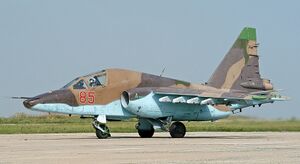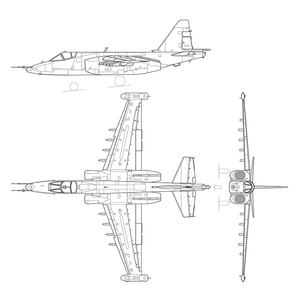AFGSF-5 Tartaruga Ground Strike Fighter: Difference between revisions
mNo edit summary |
|||
| (5 intermediate revisions by 2 users not shown) | |||
| Line 1: | Line 1: | ||
{{Infobox | {|{{Infobox aircraft begin | ||
|name | |name = Casati AFGSF-5 ''Tartaruga'' | ||
|image | |image = Image:AFGSF5ACTarturaga.jpg | ||
|caption | |caption = An AFGSF-5AC painted in CRAF woodland camouflage. | ||
|type | }}{{Infobox aircraft type | ||
|national origin = {{flag|Cacerta}} | |type = {{wpl|Close air support|Close air support fighter}} | ||
|manufacturer | |national origin = {{flag|Cacerta}} | ||
|designer | |manufacturer = Casati Aircraft Corporation | ||
|first flight | |design group = | ||
|introduced | |designer = | ||
|retired | |builder = | ||
|status | |first flight = 23 November 1981 | ||
|primary user | |introduction = | ||
|more users | |introduced = 20 December 1981 | ||
|produced | |retired = | ||
|number built | |status = In active service | ||
|program cost | |primary user = [[Image:CRAFFlag.png|border|22px]] [[Cacertian Royal Air Fleet|Royal Air Fleet]]<br>{{flagicon|Syara}} [[Commonality Air Force|Syaran Commonality Air Force]] | ||
|unit cost | |more users = | ||
|developed from = | |produced = 1982—Present | ||
|variants with their own articles = | |number built = ~850 | ||
|program cost = | |||
|unit cost = ɫ11,502,000 | |||
|developed from = | |||
|variants with their own articles = AFGSF-5<br>AFGSG-5AC | |||
}} | }} | ||
|} | |||
The '''Casati AFGSF-5 ''Tartaruga''''' ('''Tortoise''') is a single-seat, twin-engine {{wpl|close air support}} {{wpl|jet aircraft|jet fighter}} developed by Casati Air Corporation. It was designed specifically to fulfill the role of close air support for the elements of the [[Cacertian Royal Army|Royal Army]] and is one of the [[Cacertian Royal Air Fleet|Royal Air Fleet's]] only {{wpl|subsonic}} fighters. No plans to replace the AFGSF-5 have been made and it will likely continue to serve for at least another decade. | The '''Casati AFGSF-5 ''Tartaruga''''' ('''Tortoise''') is a single-seat, twin-engine {{wpl|close air support}} {{wpl|jet aircraft|jet fighter}} developed by Casati Air Corporation. It was designed specifically to fulfill the role of close air support for the elements of the [[Cacertian Royal Army|Royal Army]] and is one of the [[Cacertian Royal Air Fleet|Royal Air Fleet's]] only {{wpl|subsonic}} fighters. No plans to replace the AFGSF-5 have been made and it will likely continue to serve for at least another decade. | ||
| Line 46: | Line 51: | ||
The AFGSF-5 has seen use in a number of peace-keeping operations and saw major combat during the [[FedCom Civil War]] supporting Government loyalist and Cacertian intervention troops in [[Knichus]]. It also saw use deployed in limited numbers during the [[Nalayan Civil War]]. | The AFGSF-5 has seen use in a number of peace-keeping operations and saw major combat during the [[FedCom Civil War]] supporting Government loyalist and Cacertian intervention troops in [[Knichus]]. It also saw use deployed in limited numbers during the [[Nalayan Civil War]]. | ||
The AC variant of the Tartaruga was sold to the [[Commonality Air Force]] in 2004, seeing combat in the [[Zemplen War]]. Syara purchased 48 aircraft to augment it's fleet of attack aircraft, which included the domestically produced Corvus and Strix ground attack fighters. The CAF selected the Tartaruga based on it's heavier payload than either Syaran domestic design. The Tartarugas were split into 2 squadrons of 24 planes each, the 112th and 114th Attack Squadrons. Both squadrons saw extensive service during the Zemplen War, and while some Syaran pilots considered it superior to their own designs thanks to it's more versatile capability, like the Corvus and Strix it suffered heavy losses to Ruvelkan air defenses. By September 2009 the Syarans had lost 22 Tartarugas | The AC variant of the Tartaruga was sold to the [[Commonality Air Force]] in 2004, seeing combat in the [[Zemplen War]]. Syara purchased 48 aircraft to augment it's fleet of attack aircraft, which included the domestically produced Corvus and Strix ground attack fighters. The CAF selected the Tartaruga based on it's heavier payload than either Syaran domestic design. | ||
The Tartarugas were split into 2 squadrons of 24 planes each, the 112th and 114th Attack Squadrons. Both squadrons saw extensive service during the Zemplen War, and while some Syaran pilots considered it superior to their own designs thanks to it's more versatile capability, like the Corvus and Strix it suffered heavy losses to Ruvelkan air defenses. | |||
By September 2009 the Syarans had lost 22 Tartarugas. Efforts were underway to purchase an additional 28 aircraft, but the deal was cancelled following [[Operation Homefront]]. The CAF maintains 18 aircraft today, but has declined to purchase additional aircraft in light of transferring close air support roles to unmanned aerial vehicles and helicopters gunships. | |||
==Variants== | ==Variants== | ||
| Line 58: | Line 67: | ||
===Current Operators=== | ===Current Operators=== | ||
* {{flag|Cacerta}}; [[Cacertian Royal Air Fleet]]—805 in service as of September 2018, serving as the Royal Air Fleet’s primary close air support aircraft. | * {{flag|Cacerta}}; [[Cacertian Royal Air Fleet]]—805 in service as of September 2018, serving as the Royal Air Fleet’s primary close air support aircraft. | ||
* {{flag|Syara}}; [[Commonality Air Force]] | * {{flag|Syara}}; [[Commonality Air Force]]—18 still in service with CAF, although they are expected to be retired. | ||
==Specifications== | ==Specifications== | ||
| Line 88: | Line 97: | ||
[[Category:Cacerta]] | [[Category:Cacerta]] | ||
[[Category:Cacertian Aircraft]] | |||
[[Category:Military of Cacerta]] | [[Category:Military of Cacerta]] | ||
[[Category:Cacertian Royal Air Fleet]] | [[Category:Cacertian Royal Air Fleet]] | ||
Latest revision as of 18:45, 30 April 2021
| Casati AFGSF-5 Tartaruga | |
|---|---|

| |
| An AFGSF-5AC painted in CRAF woodland camouflage. | |
| Role | Close air support fighter |
| National origin | |
| Manufacturer | Casati Aircraft Corporation |
| First flight | 23 November 1981 |
| Introduction | 20 December 1981 |
| Status | In active service |
| Primary user | |
| Produced | 1982—Present |
| Number built | ~850 |
| Unit cost |
ɫ11,502,000
|
| Variants | AFGSF-5 AFGSG-5AC |
The Casati AFGSF-5 Tartaruga (Tortoise) is a single-seat, twin-engine close air support jet fighter developed by Casati Air Corporation. It was designed specifically to fulfill the role of close air support for the elements of the Royal Army and is one of the Royal Air Fleet's only subsonic fighters. No plans to replace the AFGSF-5 have been made and it will likely continue to serve for at least another decade.
Development
In 1971, the Cacertian Ministry of Defense decided that it was necessary to develop an assault aircraft that could support Cacertian ground troops in a way that the Royal Navy's guns could not. The Royal Air Fleet historically possessed ground-attack aircraft which were utilized during the Great War to help curtail the advance of Acrean ground forces following their invasion of the Home Islands. Since then, however, no specific aircraft designs had been created.
Taking into account newer and modern technologies that had been used in previous designs, a team of military engineers at the Casati Aircraft Corporation began the process of developing a purpose-built close air support aircraft. In 1979, CAC created a vehicle that was maneuverable at low altitudes as well as possessed enough armor plating to protect the pilot and vital equipment from ground fire and missile hits. Designated the Tartaruga, it was introduced to the Cacertian Armed Forces in 1982.
Production
Casati is the sole producer of the AFGSF-5 and entered serialized production in 1982. Nearly all CRAF bases are equipped with the AFGSF-5 and there are rumors of a carrier-capable variant under development.
Although the Tartaruga was not originally intended to be exported, Syara approached the Cacertian military and negotiated a purchase of 48 AFGSG-5ACs to supplement their large attack aircraft fleet.
Production Figures
Since 1982, approximately 850 AFGSF-5s and their variants have been produced and are in active service.
Design
Differing greatly from other Casati designs, the AFGSF-5 can easily be identified by its conventional aerodynamic layout. It possesses a shoulder-mounted trapezoidal wing with a traditional tailplane and rudder. In an unconventional design trait, the AFGSF-5's air brakes are housed in fairings at the tip of each wing.
The AFGSF-5 has five hardpoints underneath each wing with the ability to load and carry a variety of weapons. As such, it can quickly be specialized for a number of different ground-mission parameters. Its 30 mm cannon is located in a compartment beneath the cockpit and mounted on a load-bearing beam that is attached to the forward fuselage support structure.
Operational History

The AFGSF-5 has seen use in a number of peace-keeping operations and saw major combat during the FedCom Civil War supporting Government loyalist and Cacertian intervention troops in Knichus. It also saw use deployed in limited numbers during the Nalayan Civil War.
The AC variant of the Tartaruga was sold to the Commonality Air Force in 2004, seeing combat in the Zemplen War. Syara purchased 48 aircraft to augment it's fleet of attack aircraft, which included the domestically produced Corvus and Strix ground attack fighters. The CAF selected the Tartaruga based on it's heavier payload than either Syaran domestic design.
The Tartarugas were split into 2 squadrons of 24 planes each, the 112th and 114th Attack Squadrons. Both squadrons saw extensive service during the Zemplen War, and while some Syaran pilots considered it superior to their own designs thanks to it's more versatile capability, like the Corvus and Strix it suffered heavy losses to Ruvelkan air defenses.
By September 2009 the Syarans had lost 22 Tartarugas. Efforts were underway to purchase an additional 28 aircraft, but the deal was cancelled following Operation Homefront. The CAF maintains 18 aircraft today, but has declined to purchase additional aircraft in light of transferring close air support roles to unmanned aerial vehicles and helicopters gunships.
Variants
- AFGSF-5
The basic version of the aircraft that entered full production in the first months of 1982. This variant of the aircraft, sometimes denoted AFGSF-5P (Primo), forms the backbone of the Royal Air Fleet’s ground attack aircraft.
- AFGSF-5AC
The AFGSF-5AC (Anticarro) is a dedicated anti-armor version of the AFGSF-5 that saw notable success engaging Optikhalee armored fighting vehicles during the FedCom Civil War. The AFGSF-5AC is characterized for its all-weather and night attack capabilities as well as its ability to employ TV-guided and laser-guided bombs and missiles.
Operators
Current Operators
 Cacerta; Cacertian Royal Air Fleet—805 in service as of September 2018, serving as the Royal Air Fleet’s primary close air support aircraft.
Cacerta; Cacertian Royal Air Fleet—805 in service as of September 2018, serving as the Royal Air Fleet’s primary close air support aircraft. Syara; Commonality Air Force—18 still in service with CAF, although they are expected to be retired.
Syara; Commonality Air Force—18 still in service with CAF, although they are expected to be retired.
Specifications
General Characteristics
- Crew: 1
- Length: 15.5 m (50 ft 11 in)
- Wingspan: 14.4 m (47 ft 2 in)
- Height: 4.8 m (15 ft 9 in)
- Wing Area: 33.7 m² (323 ft²)
- Empty Weight: 9,800 kg (21,605 lbs)
- Loaded Weight: 14,600 kg (32,187 lbs)
- Max Takeoff Weight: 17,600 kg (38,000 lbs)
- Powerplant: 2 x Cas-AFGSF5-81 Turbojets
- Fuel Capacity: 6,400 kg (14,110 lbs)
Performance
- Maximum Speed: Mach 0.8 (975 km/h, 606 mph) at sea level
- Cruise Speed: 800 km/h (497 mph)
- Service Ceiling: 7,000 m (22,965 ft)
- Rate of Climb: 58 m/s (11,400 ft/min)
Armament
- Guns: 1 x 30 mm cannon with 1000 rounds
- Payload: 4,000 kg (8,800 lb) on 11 external hardpoints (10 underwing, 1 underbelly)

